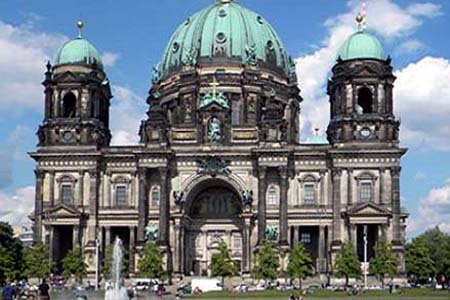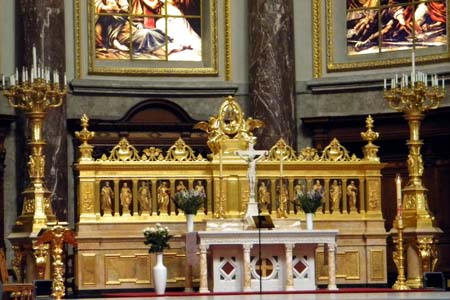| |
 |
 |
 |
| Comment on this report, or find other reports. |
 |
| Our Mystery Worshippers are volunteers who warm church pews for us around the world. If you'd like to become a Mystery Worshipper, start here. |
 |
| Find out how to reproduce this report in your church magazine or website. |
|
|
| 2185: Berliner
Dom, Berlin, Germany |
 |
 |
 |
Mystery
Worshipper: Paterfamilias.
The church:
Berliner
Dom, Berlin, Germany.
Denomination:
Evangelical Church Berlin-Brandenburg-Silesian Upper Lusatia
(Evangelische
Kirche Berlin-Brandenburg-schlesische Oberlausitz).
This is one of the 22 national member churches (Landeskirchen)
that make up the Evangelical Church of Germany (Evangelische
Kirche in Deutschland). Some Landeskirchen are Reformed,
some Lutheran, and some United. The church in the Berlin area
is United.
The building:
The Dom, reminiscent of St Peter's in Rome, was consecrated
in 1905; it is the largest Protestant church in Berlin. It suffered
extensive damage in an air raid in May 1944, and an extensive
rebuilding program was not begun until 1975. This brief description
does not begin to depict the extraordinary beauty of this space.
It is lavishly decorated, with some of the architectural high
points being the mosaics in the dome representing the Beatitudes;
the statues of Zwingli, Luther, Melanchthon and Calvin in the
front of the church; and a gilt screen with figures of the twelve
apostles. Behind this Apostelwand is a mosaic based
on a painting of St Peter by the 17th century painter Guido
Reni; it was a gift to Friedrich Wilhelm III from Pope Leo XII
as a symbol of "undivided Christendom". In addition to
the main worship space, there is a much smaller baptism and
marriage chapel. And the church is also the home of the Hohenzollern
Crypt, where many of the members of that royal family are buried.
The church:
The Berliner Dom holds a place in German life somewhat akin
to Westminster Abbey in England or the Washington National Cathedral
in the United States (the latter analogy does not hold quite
as well). There is an extraordinary concert series; the Dom
is the home of two choirs and a thirteen member brass choir.
The Dom is a Personalgemeinde, meaning that geographically
there are no parish boundaries; any baptized Protestant Christian
living in the Berlin area can join the congregation. There are
several services each Sunday and during the week, as well as
regular meetings for older people, weekly activities for families,
and regular community get-togethers.
The neighborhood:
The Berliner Dom is on Museum Island, the home of many of Berlin's
most notable museums. It is also only a block and a half from
another historic church, the Marienkirche.
The cast:
The Liturgin (officiant) was Sabrina Ludwig, assisted
by Dr Andrea Schaefer, reader. I really could not distinguish
any difference between their roles, save that Ludwig led the
parts of the service that were in German, and Schaefer the parts
that were in English. Ludwig was vested, Schaefer was not. David
Clark was the organist.
The date & time:
Thursday, 19 May 2011, 18 Uhr (6.00pm).
What was the name of the service?
Musikalisches Abendgebet (Evensong).
How full was the building?
I found it difficult to estimate how many worshippers the Dom
can hold, but it's certainly in the thousands. Sadly, there
were no more than 35 of us scattered throughout this huge worship
space.
Did anyone welcome you personally?
We were in line on the steps of the Dom with a group of tourists
wanting to see the building; we had to explain that we actually
did want to attend the worship service. As we entered the worship
space, a service leaflet was handed us.
Was your pew comfortable?
Padded, and very comfortable indeed.
How would you describe the pre-service
atmosphere?
Quiet and reverential. Bells were rung before the organ prelude.
What were the exact opening words of the
service?
The opening sentence, first in German and then in English: "Therefore,
if anyone is in Christ, he is a new creation; the old has gone,
the new has come." (2 Corinthians 5:17.)
What books did the congregation use during the
service?
None, save for the above-mentioned service leaflet. Left hand pages were in German, right hand pages in English.
What musical instruments were played?
The Dom's organ, built by the Frankfurt firm of Wilhelm Sauer
Organbuilders and consecrated at the same time as the Dom itself.
It is one of the largest Romantic era organs anywhere, with
7269 pipes, 113 ranks, four manuals and pedalboard. It was featured
prominently in the service.
Did anything distract
you?
Distraction may not be the word, but there is so much visual
stimulus in this space. Given that the spoken word is not easily
understood in so large a space, I was constantly tempted to
took at the mosaics in the dome, or stare back at Zwingli's
austere gaze.

Was the worship stiff-upper-lip,
happy clappy, or what?
Formal, yet without any ceremonial. The two women leading the
service processed in, processed out, and otherwise went about
their business of leading the service with minimal movement.
Parts of the service were read in German, then English, or in
German and English simultaneously (the two congregational hymns
and Lord's Prayer). Interspersed into this simple framework
of reading, prayer, and blessing were major organ works of Bach
and Vierne as well as an improvisation before the first congregational
hymn.
Exactly how long was the sermon?
There was none.
Which part of the service
was like being in heaven?
The beauty of the space, and Daniel Clark's impressive skills at the organ, both as soloist and accompanist to the congregation.
And which part was like being in... er... the other place?
Being part of such a small congregation in such a large space,
and thus so widely separated from my fellow worshippers. I found
myself wondering why the service was not held in the smaller,
but still impressive, baptism and marriage chapel (which also
has an organ).
What happened when you
hung around after the service looking lost?
We all understood we needed to depart so that the tourists could
return. Sabrina Ludwig was at the back of the church to greet
us.
How would you describe
the after-service coffee?
There was none. I was with a group of relatives and friends,
and we retired to a nearby restaurant for dinner and wine.
How would you feel about making this church your regular (where 10 = ecstatic, 0 = terminal)?
3 – I don't want to seem critical, but I simply would not
have a clue as to how to be a part of such a large parish. And
if we were to move to Berlin, I'm fairly sure I would be happier
at the Dom's much smaller neighbor, the Marienkirche.
Did the service make you feel glad to be a
Christian?
Yes. It is good to see the Dom interrupt its role as Berlin tourist attraction to offer the prayers of the church on a daily basis.
What one thing will you remember about all this in seven days' time?
David Clark's quite impressive organ playing, and the extraordinary
instrument on which he played. |
|
|
 |
 |
 |
| We rely on voluntary donations to stay online. If you're a regular visitor to Ship of Fools, please consider supporting us. |
 |
 |
 |
| The Mystery Pilgrim |
 |
| One of our most seasoned reporters makes the Camino pilgrimage to Santiago de Compostela in Spain. Read here. |
 |
 |
 |
| London churches |
 |
| Read reports from 70 London churches, visited by a small army of Mystery Worshippers on one single Sunday. Read here. |
| |
|
|
|
|


